

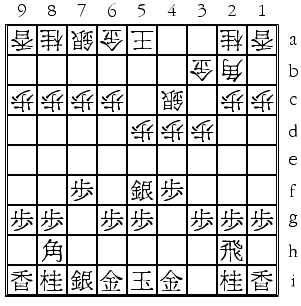
After 6... P5d
The system beginning with 7 P4e (instead of the standard 7 R4h, usually met by ... N3c) is a very old one, known as "quick attack" (but rather misnamed, as it usually leads to a slow game!), which is sometimes recommended by pros. However the specific plan used here, involving R-4h-4i-8i, is known as the "subway rook" as the rook's movement suggests that it took an underground train. I don't know who invented it, but it was played in Tokyo on July 18, 1972, by Student Meijin Kurokawa (amateur) against Nakahara Makoto Meijin, Kurakawa winning fairly easily. The game was nearly identical to Eric's game vs. Habu up to move 23; the only differences in the position were that the 9th file pawns were not pushed, the moves P1e and P8f were not played, and white had chosen ... P2d instead of ... P1d. Black played P6f (actually he played it some moves earlier), so as to meet P5e by S6g, which looks better than having to retreat to 4g as Eric did. Black then won with an attack on the 8th file, similar to Eric's win.
This game was shown by Horiguchi Koji 6 Dan to George Hodges, who had planned to run it in his magazine which unfortunately stopped publication. The pro had told George that it was a "sure win" system for black. He sent me the game two years ago, and I was impressed by the idea. I never got to use it, as in recent years I always play pros at bishop, but I showed the idea to Marc Theeuwen who was visiting D.C. Although Marc had a terrible record of countless losses to pros at rook prior to this, he immediately won games from pros Ishikawa Akio and Kondo Masakazu with this system. Ishikawa defended as in the Nakahara game but kept his right gold at 6a to slide to 7a when needed for defense, while Kondo chose the setup K5b and G7b (which I think is tougher for black than the K7b setup), but still the system worked fine for Marc. Marc later explained it to Eric for use against Takano Hideyuki 4 Dan and now against Habu Yoshiharu 4 Crowns. So far as I know, the only failure of the system was a loss by George Fernandez against Yonenaga Kunio 9 Dan, but I believe that George did not study the system enough and did not play it correctly.
Does all this mean that rook handicap is "busted" or solved ? Not quite. It seems to me that once the bishops are exchanged, the game is indeed pretty difficult for white. One possible solution: meet 7 P4e by G5b, avoiding the bishop trade. Pros rarely do this, because after 8 R4h they have been "tricked" into playing a defense (G5b) that was not their intended defense to 7 R4h (namely 7... N3c). Nevertheless, the G5b defense is quite playable and theory exists on it. Still, black can be satisfied that he has avoided the "best" defense (7... N3c), which experience shows is quite difficult to defeat.
Here is the 1972 Student Meijin Kurokawa (amateur) against Nakahara Makoto Meijin game, with comments by me based partly on comments by Horiguchi Koji 6 Dan :
1... P3d 2.P7f P4d (2... G3b is another line, but since it also usually leads to a bishop exchange like our main line, I won't discuss it further) 3 P4f G3b 4 S4h S4b 5 S4g S4c (5... S3c or 5... G5b 6 S5f S3c avoids the bishop exchange, but is rarely played as the bishop is blocked and the silver is a target for a later N3g-2e) 6 S5f P5d (not 6... N3c? because of 7 S5e) 7 P4e
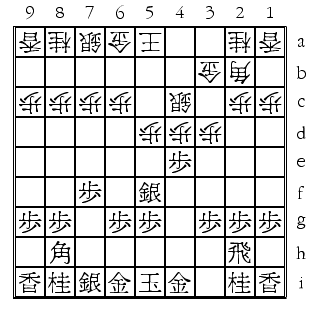
After 7.P4e
(The so-called but misnamed "Quick Attack". Usual is 7 R4h N3c, but it is quite difficult for black to attack successfully in some of the ensuing variations) Px4e (Probably better is 7... G5b, in view of this game, but if so after 8 R4h black has "forced" white to play the second-best defense to 7 R4h) 8 Bx2b+ Gx2b 9 Sx4e P*4d 10 S5f N3c (This allows 11 B*3a and promoting the bishop, but prevents black from exchanging the 2 pawn, as 11 P2f can be met by P2d. Books recommend that black promote the bishop or exchange the 2 pawn, based on white's tenth move, but for the system recommended here black does neither, so white's tenth move makes no difference) 11 R4h (keeping the bishop in hand is the key to this system; the threat of bishop drops severely inhibits white's freedom of action) G3b 12 S7h K6b 13 K6h G5b 14 S7g K7b 15 K7h S6b 16 P7e!
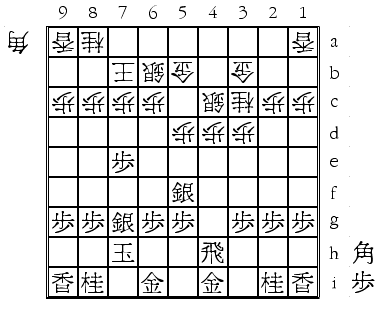
After 16.P7e !
(This vanguard pawn is the key to this system) S5c 17 P6f (to give the 5f silver a retreat which will make a nice castle) P3e 18 G3h! (another key move; the gold defends the right flank perfectly) P4e 19 G6h P2d 20 S7f S5c4d 21 N7g P5e 22 S56g P3f (To promote the bishop and get some play. Otherwise black will simply play R4i, P8f-8e, and R8i with a one-sided game. The reason this system scores so well for black is that it is so difficult to suggest good moves for white) 23 Px3f B*5i 24 R4i 25 B1e+ 25 P8f P2e 26 P8e P2f 27 Px2f +Bx2f 28 R8i P4f 29 P8d Px8d 30 Rx8d P*8b 31 R8i N4e 32 P*8c Px8c 33 B*6e
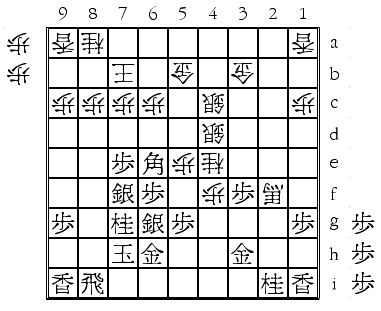
After 33.B*6e
(note how keeping the bishop in hand gave black a decisive attack) P*3g 34 G4h K6b 35 Bx8c+ P*2h (with some slight hope for an entering king) 36 +B6e Px2i+ 37 Rx8a+ P3h+ 38 Gx3h K5c 39 +R2a N*8f 40 K7i +Bx3f 41 +Rx3b Sx3b 42 +Bx3b P*8g
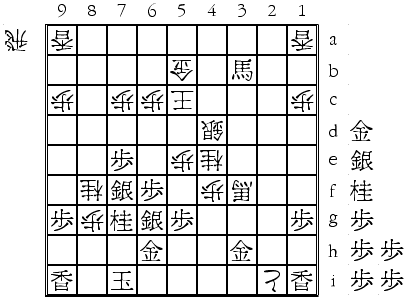
After 42... P*8g
43 Sx8g (Better was 43 N6e K6b 44 P7d R*5i 45 N*6i Px7d 46 S*7c K5a 47 P*4c, winning) Nx5g+ 44 N6e K6b 45 Sx8f +Nx6h 46 Kx6h R*6i 47 K7g G*8g 48 K7f Gx8f 49 Kx8f R8i+ 50 P*8g S*8e 51 Kx8e +Rx8g 52 P*8f P*8d 53 Kx8d +Rx8f 54 P*8e and white resigned.
In the following two games, Eric followed the system except for leaving out the important move P6f which gives the silver a nice retreat square on 6g. The result is that white got more counterplay than in the Nakahara game, but the fact that Eric still won both games decisively shows just how hard this system is for white to beat.
[Sente "Eric Cheymol, amateur 4 Dan"]
[Gote "Yoshiharu Habu, 4 Crowns"]
[Date "2002/05/22"]
[Site "Paris"]
[Handicap "Rook"]
[Result "1-0"]
1.... P3d 2.P7f P4d 3.P4f G3b 4.S4h S4b 5.S4g P5d 6.S5f S4c 7.P4e Px4e
8.Bx2b+ Gx2b 9.Sx4e P'4d 10.S5f G3b 11.K6h K6b 12.K7h K7b 13.R4h N3c
14.S6h S6b 15.S7g S5c 16.P7e G5b 17.S7f P3e 18.G3h P9d 19.P9f P1d 20.G6h
P1e 21.P8f P4e 22.N7g S54d 23.R4i P5e 24.S4g P2d 25.R8i P6d 26.P8e B'5d
27.R8f G6c 28.P6f P1f 29.Px1f P4f 30.S5h P3f 31.P6e Px6e 32.P'6d
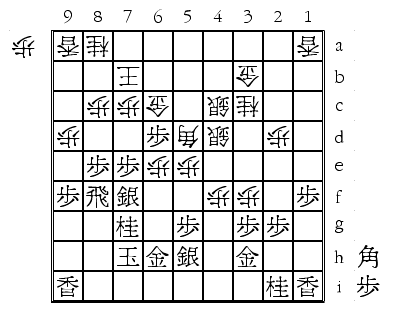
After 32.P'6d
{Very good move, if Sx6e then B5e, K8h, P'6d, S7f and the game is unclear - Yoshiharu Habu} Gx6d 33.P8d Px8d 34.Rx8d P7d 35.Px7d {The key move - Yoshiharu Habu} P'8c 36.P7c+ Kx7c 37.B'5a

After 37.B'5a
K6c 38.Rx8c+ K5b 39.B8d+ P6f 40.+R8b P'7b 41.+Rx8a Bx7f 42.+Rx7b {Resigns}
[Sente "Eric Cheymol, amateur 4 Dan"]
[Gote "Hideyuki Takano, 4 Dan"]
[Date "2000/10/26"]
[Site "Paris"]
[Handicap "Rook"]
[Result "1-0"]
1.... P3d 2.P7f P4d 3.P4f G3b 4.S4h S4b 5.S4g S4c 6.S5f P5d 7.P4e Px4e 8.Bx2b+ Gx2b
9.Sx4e P'4d 10.S5f G3b 11.K6h G5b 12.K7h K6b 13.R4h N3c 14.S6h K7b 15.S7g S6b 16.P7e S5c
17.S7f P3e 18.G3h P9d 19.P9f P2d 20.G6h P2e 21.P8f S6d 22.B'6f G5c 23.N7g B'1b 24.R4i P5e
25.S4g S5d 26.R8i N4e 27.P8e G3b4c 28.P9e Px9e 29.P'9d Nx5g+ 30.Bx5g P5f 31.B3i S5d5e 32.Lx9e P'9b
33.P8d Px8d 34.P'8e P4e 35.Px8d P'8b 36.N'8c P4f 37.S5h P7d 38.Nx9a+ Px7e 39.S8e N7c 40.S7d P5g+
41.Bx5g P7f 42.P8c+ K6b 43.+Px7c Sx7c 44.Sx7c+ Kx7c 44.N6e K6d 46.Rx8b+ Kx6e 47.+R8d S'7g
48.K8g G6d 49.L'6f S5ex6f 50.Px6f K5d 51.S'6e K5c 52.P'5d K4b 53.Sx6d Px6d 54.Kx7f Sx6h+
55.Bx6h B7h+ 56.P'4d
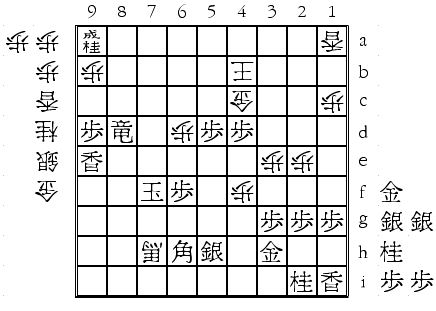
After 56.P'4d
+Bx6h 57.Px4c+ Kx4c 58.P5c+ Kx5c 59.N'4e K5d 60.+Rx6d Kx6d 61.S'6e K5e 62.G'5d {Resigns}
Lessons from the subway rook :
Move order is important to reach the desired formation. The key points of move order are :
1... P3d 2 P7f P4d 3 P4f G3b 4 S4h S4b 5 S4g S4c 6 S5f P5d 7 P4e G5b (a similar defense is 7... S6b 8 R4h S5c, but after 9 Px4d white must settle for S5cx4d 10 P*4e S3c since other continuations allow a bishop or silver drop on 8b; then P3f followed by castling and an eventual N3g-2e should be good for black) 8 R4h (This position would normally arise with black's seventh and eighth moves reversed) G5c 9 P3f (Here black does not want to invite exchanges by taking on 4d as there is no open drop square in white's camp; that's why 7... G5b is considered better than 7... S6b) K6b 10 N3g K7b 11 G6h (This is better than K6h-7h because it is sometimes advantageous for black not to have the king on 7h so that ... BxB will not be check) S6b 12 K6i P9d 13 P9f P6d (13... Px4e 14 Bx2b+ Gx2b15 B*7g B*4d 16 Sx4e Bx7g+ 17 Nx7g P*4d 18 N6e ends up in black's favor) 14 K7h B3c (and now 14... Px4e 15 Bx2b+ Gx2b 16 B*6f [note that black picks a square which is not next to his king, avoiding check in some lines] B*4d 17 Nx4e G5b 18 Bx4d Sx4d 19 B*3a G3b 20 Bx6d+ G6c 21 +B4f B*6d 22 +Bx6d Gx6d 23 G3h with a nice advantage since 23... P5e ? would be met by 24 S6e!) 15 B6f!
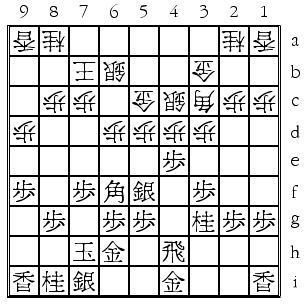
After 15.B6f !
(This is the key move against ... B3c, so that ... Px4e can be met by 16 Nx4e Bx6f 17 Nx5c+) S6c 16 G4i5h P7d 17 P8f (Black is in no hurry to start action by Px4d, since white cannot take on 4e due to the knight fork) N7c
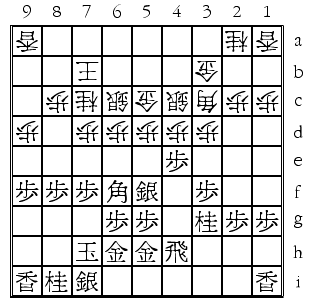
After 17... N7c
(by threatening ... P6e driving the bishop back to a square next to the king, followed by ... Px4e, white forces black to attack. But the knight on 7c becomes a target. If white just made passing moves, black would strengthen his position by S8h-8g before starting action) 18 Px4d Bx4d 19 Bx4d Sx4d 20 P7e Px7e (20... P*4c 21 Px7d N6e 22 B*7c) 21 P*7d N6e (21... Sx7d? 22 B*4a) 22 Rx4d!!
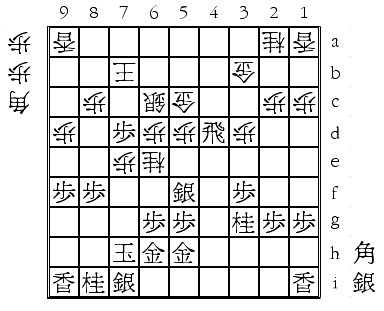
After 22.Rx4d!!
Gx4d 23 B*5c G4d4c 24 S*7c K8a 25 B6b+ B*4a 26 +Bx6c Bx6c 27 S*8b K9b 28 P9e P8d 29 Px9d K8c 30 Sx6d+ Kx8b 31 P7c+ followed by +Sx6c winning.
These variations seem a bit complicated, but if you remember to castle by G6h, then K6i-7h and then G45h, meet ... B3c by B6f, and try to postpone Px4d until ... N7c provides you a target, you should do fine. Remember that once you are castled, it may be possible to sacrifice your rook for a general and a strong attack.
Most of the analysis of this line is based on the handicap book by Shoshi Kazuharu 6 Dan.